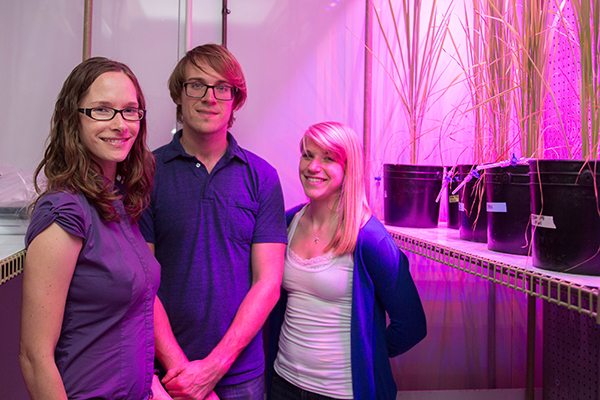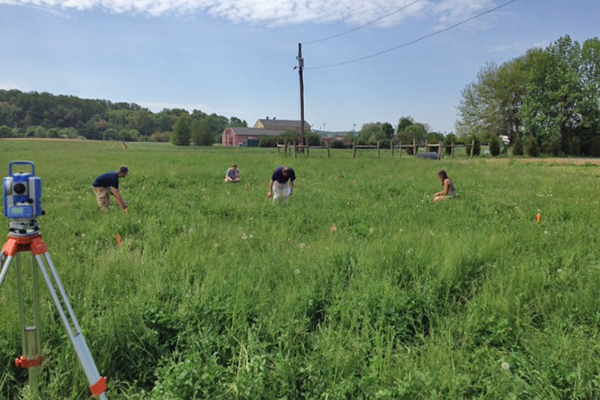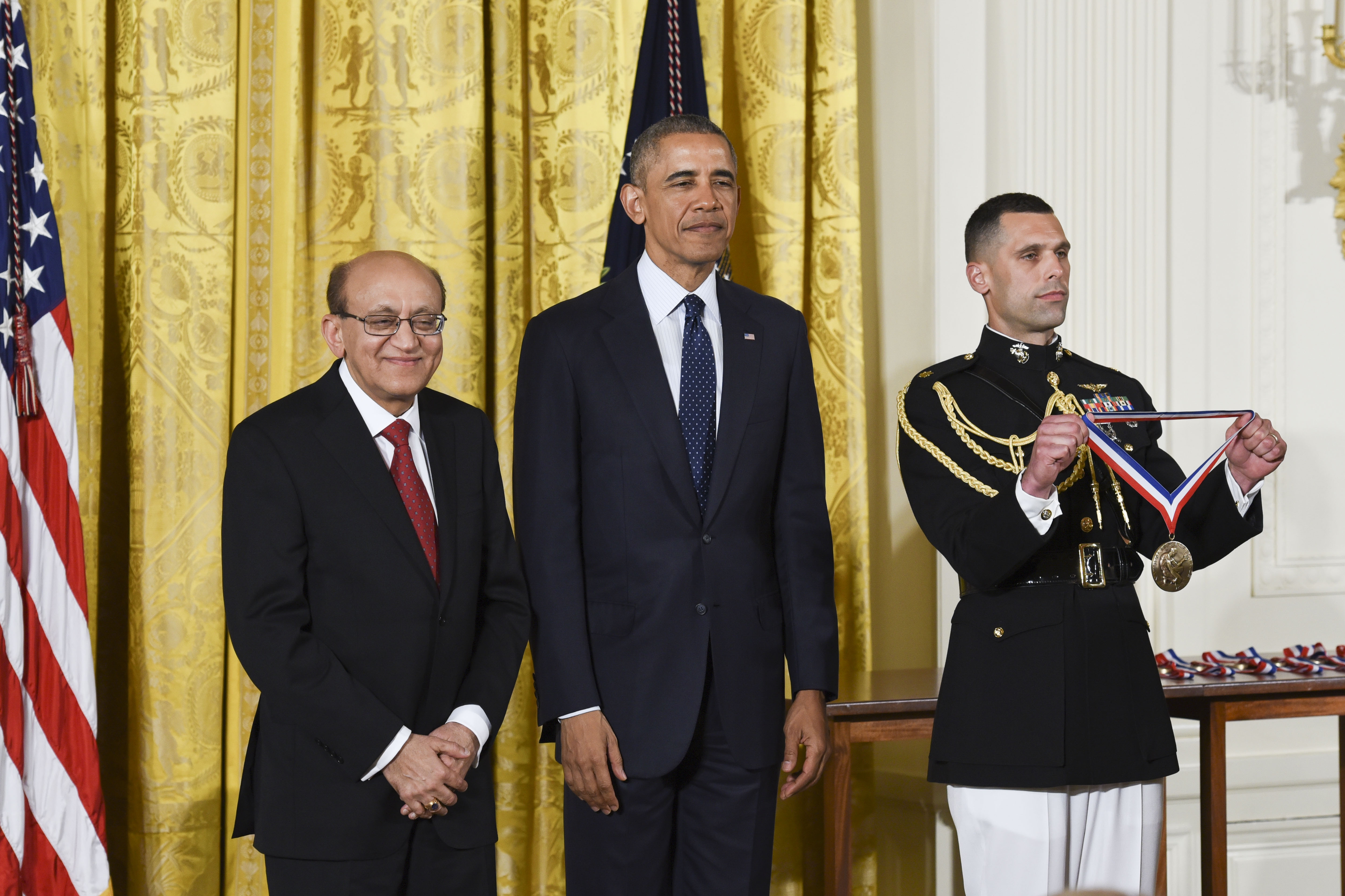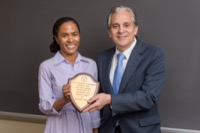


NSF Career Award
UD's Seyfferth to create rice paddies to study ways to lower arsenic levels in rice
1:27 p.m., Sept. 23, 2014--The University of Delaware’s Angelia Seyfferth has received a prestigious five-year, $465,000 National Science Foundation (NSF) Faculty Early Career Development Award for studies on arsenic in rice, and the funding will provide for the installation of the first rice paddies in the state.
The rice paddies, to be created on the College of Agriculture and Natural Resources (CANR) campus in spring 2015, will not only aid Seyfferth’s research on potential methods to lower arsenic levels in rice – a staple crop for nearly half of the people on Earth – but they will also provide an important teaching tool for UD graduate and undergraduate students, and local high school and middle school students, as well.
Honors Stories
National Medal of Science
Warren Award
Seyfferth, assistant professor in CANR’s Department of Plant and Soil Sciences, is the first recipient of an NSF Career Award in the college and CANR Dean Mark Rieger said he is thrilled that Seyfferth has received the award.
“To my knowledge it is the first one that has been awarded to our college, so it's definitely a milestone and a reflection of the caliber of our most recent hires,” said Rieger. “The best part of the NSF Career program is the intentional and thorough integration of teaching and research, which means that students will also benefit from this award."
Blake Meyers, chair of the Department of Plant and Soil Sciences and the Edward F. and Elizabeth Goodman Rosenberg Professor of Plant and Soil Sciences, added that the award shows the great work and research conducted by Seyfferth.
“Her work is exceptional, focused on the coupled effects of plant and soil processes on trace element and nutrient cycling in the rhizosphere,” said Meyers. “Through her research and teaching supported by the NSF Career award, she will bring together and build on many aspects of our departmental expertise in plants and soils. I'm thrilled for her and to have her as a colleague in our department."
Research and teaching
Seyfferth said the award requires almost equal weight to be put on the research and teaching components.
“With all NSF awards, the broader impacts of the research are important, but this particular award is about the integration of the research with the education,” Seyfferth said. “It’s not just doing research but really how you integrate education into the research.”
As such, a major component of the project will be the establishment of a dozen small rice paddies at a new outdoor research education laboratory – the Rice Investigation, Communication and Education (RICE) Facility – to be built in cooperation with students in UD’s landscape design program.
The facility will enable field experiments and integrate research with educational outreach, and Seyfferth said plans are in the works to involve high school and middle school students.
Arsenic research
Arsenic is a cancer-causing compound that can show up in drinking water or food. Humans can get exposed to arsenic through ingesting food or water that has arsenic, and the toxic effects depend on the concentrations of arsenic in the food or water as well as the dose – the amount of food or water that is ingested.
Rice tends to have more arsenic compared to other cereal crops and arsenic in rice is an especially important issue for people who eat a lot of rice. Since over half the world’s population depends on rice as a staple food, finding ways to lower arsenic in rice is extremely important.
Seyfferth’s research will look at different ways to decrease arsenic concentrations in rice grains while also increasing yield. Her research will consider arsenic dynamics in the soil solution as well as within the plants themselves, from the water the plants are in contact with to the grains that people eat.
It will also look at how management practices could affect the biogeochemistry of carbon and iron dynamics. For example, iron oxides precipitate on the outside of a plant’s roots and are thought to absorb arsenic before it can get taken up by a plant, and adding organic matter into the soil as a way of soil management could enhance carbon cycling and methane production.
“If we were to incorporate a material into the soil with the goal of decreasing arsenic levels in rice, we want to be sure we are not creating another environmental problem in the process – by increasing greenhouse gas emissions from soils. We are ultimately looking for an economical and sustainable solution that could be adopted by farmers in the U.S. and especially in developing countries where arsenic contamination and poisoning is a critical issue,” said Seyfferth.
UD rice paddies
Seyfferth is already growing rice in rice chambers at UD to conduct the research, but she will be aided in an important way with the construction of the RICE Facility paddies on UD’s Newark farm in the spring of 2015.
“Some people might laugh and say, ‘Why would you want to grow rice here?’ Well, there’s no reason that you can’t grow rice here in Delaware,” said Seyfferth. “As long as everything more or less stays the same, we can expect to have relatively humid summers. In terms of the growing season, we’d only be able to grow rice in the summer but we’d be able to have enough time to grow a four-month rice crop.”
The RICE Facility’s 12 paddy mesocosms were designed in conjunction with Carmine Balascio, associate professor of plant and soil sciences, and his students in a landscape design course.
Seyfferth said the students came up with a grading plan and a design for building the rice paddies with water management in mind. In addition to the excavating team Seyfferth is hiring, some of the students from the class will have a hand in the actual construction of the RICE Facility.
Seyfferth and her team will grow different varieties of rice each year and at the end of the study they will have a large data set of several globally important rice varieties. Plants will be grown in the RICE Facility in summers, and in environmental chambers in the Fisher Greenhouse Laboratory in the fall and winter.
“Specifically, we will grow varieties that are important for both the U.S. and for Southeast Asia, where arsenic in rice and in drinking water is a huge problem affecting more than 100 million people,” said Seyfferth.
Teaching component
Graduate and undergraduate researchers in Seyfferth’s laboratory will work on the rice paddy fields and students from her class, Humans and Environmental Sustainability, will also have a chance to learn about the paddies.
In addition, students from Newark High School will have the opportunity to work on the paddies in the summer and middle school students from Serviam Academy will have a one day summer camp – called Soil is Life – to learn about the importance of soil in food production.
Seyfferth said that the grant has funding to pay the high school students to work on the research project. This will provide a unique opportunity for these young students eager to pursue scientific interests.
“When I was a student, I wish I had an opportunity like that but I always had to get a side job and work, so the high school students are actually going to get paid hourly to work in the summertime,” said Seyfferth. “I don’t want them to have to make a choice between having that hands-on experience and working so they can do both at the same time.”
Article by Adam Thomas
Photos by Lindsay Yeager and courtesy of Angelia Seyfferth









